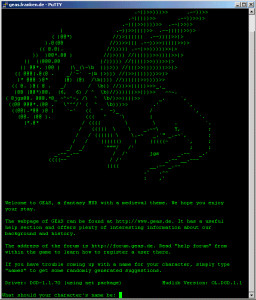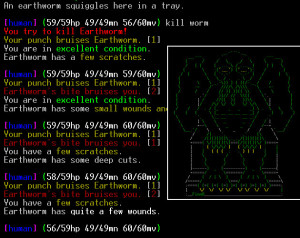To those close to me, my nose for the deliciously musty smells of outmoded technology is as much a part of my DNA as my bushy brown beard. Roughly five years ago, tiny bits of news carrying a particular name floated through the ether, attracting me with the aroma of a time when flash and bang graphics were still just a twinkle in a developer’s eye. I speak of Richard Bartle, one of two heads responsible for MUD1, the aptly titled first MUD, or Multi-User Dungeon. Bartle was receiving the Online Game Legend Award which I can appreciate, but my attentions were drawn to something I had not done in a long, long time. It was as though a slumbering sliver of grey matter woke within my fuzzy noggin and wondered what had happened to those fun little text adventures that had crashed through the barriers of so many bedtimes, much to my mother’s dismay. As it turns out, MUD gaming and its associated spin-offs are quite alive and well thanks to a community that keeps the gears turning by playing and developing within the confines of what amounts to a rather delightful rabbit hole.
The acronym name is probably the best way to approach explaining what is a MUD is. It breaks down to Multi-User Dungeon, which speaks of the online multiplayer adventuring aspect. Around 1978, Roy Trubshaw, the Arneson to Bartle’s Gygax and primary figure in the creation of MUD1, intended the name to convey the core aspects of the game. The caveat here is that this world and the adventures in it will be delivered entirely in text, perhaps containing a few drips of ASCII art here and there. This is typically where most people walk back out the door they came in, since reading and typing beyond one hundred and forty or so characters is apparently a colossal chore. However, there are tricks to lessen the load, depending on the connection client and game features.
Simply explaining a MUD as a text-based adventure is overly reductive. In fact, text-based adventure games are typically regarded as being separate from MUDs in that they are solo play, and generally do not require an internet connection. However, it is hard to discuss MUDs without bringing the phrase up. The player will find themselves connected to a world, rolling a character, and issuing commands via a prompt to make anything happen, including simple movement.
What I find most remarkable about MUDs is that they recreate a sort of Dungeons and Dragons atmosphere for me, and I do not mean simply handing me a fantasy setting in which to roll up a character and battle my way through this or that. It is really more about the employment of my own imagination mixed with that of the game’s creator. This offers a different experience from today’s modern games where the world and characters are delivered to us through some, at times, utterly stunning graphics and animation. While I certainly appreciate a game with great art, I am also drawn to games that engage me with that extra imaginative step. The player is free to envision a character or setting in their own minds with some information cues, the same way a skilled Dungeon Master will cultivate an environment ripe for personal participation without letting anyone deviate so far as to step outside the bounds of the fictional world.
It is entirely possible that Brad McQuaid had the same feeling toward MUDs, but I do not have the Will modifier required to break his piercing gaze each time I want to ask. What I do know is that he drew inspiration from his enjoyment of MUD gaming to create the beloved MMO EverQuest. In a way, MUDs were ahead of their time when they took advantage of the increasing availability of modems and personal computers, and have always been something of an anachronism. While the gaming market continued to produce physical media on closed systems, MUDs were intended to be social games from their infancy onward.
Interestingly, there appears to be no end in sight to the longevity of MUDs and the surrounding community. I posit two possible reasons for this, one being that they are typically free. Should anyone choose to explore the vast list on The MUD Connector, they will be presented with a variety of choices, such as CthulhuMUD and Aardwolf. Many even offer custom clients and play direct from the game’s website, showcasing custom features to augment the game experience and abate some of the text tracking. There are some monthly subscription MUDs to choose from as well, where the player is paying a fee to ensure active development and heavy moderation. This is worth noting as many free MUDs are digital ghost towns, having suffered losses in user base and Imps, a colloquial term for those who implement content for players to adventure in. One of my favorites, Netrunners, a cyberpunk themed RPG, actually disappeared without a trace from the internet about a year after I started playing it.
A few dying MUDs do not seem to be stopping the community, though. My second suspected reason for the seeming permanence of MUD gaming is a motivated fan base for world building. There is no shortage of creation tools out there, ranging from the tried and true DikuMUD to the newer Evennia, a builder toolbox in the popular Python language. Should someone wish to try their hand at crafting a world, but is lacking in coding knowledge, The Builder Academy, or tbaMUD offers a place for imaginative types to test their chops with room descriptions and mapping while teaching some minor code used for triggers and mobs. Over the years, I have learned that it is not uncommon for coders and programmers to use MUDs and their toolboxes as stepping stones to wider game development. I even tried my own hand at it a few times, and had a blast creating small areas that could be incorporated into a larger game, though in the end, I prefer to simply play during what little free time I have. I suppose I mention it because if I can learn it with absolutely zero previous coding experience, anyone can, and that says something about how helpful the community is.
There is a possible third reason for continued MUD patronage, and it has to do with access. Outside of stock video game consoles, it is possible to connect and play to a MUD on any device with even the most basic of Telnet clients and a keyboard. There are even apps for Android and iPhone, though I personally cannot deal with the screen limitations of using mobile to play, since typing accurately and quickly is a demand of so many MUDs. Regardless of my ineptitude with a touchscreen keyboard, connecting to a MUD and playing only costs a pinch of effort with devices we already own, and low hardware demand means that older computers will not have some horrendous meltdown.
Through the evolution of the gaming industry, MUDs have retained their original shape and structure, but most importantly, they have remained fun. Entire books have been written on the subject of MUDs, and I could probably continue for a frightening amount of time, digging into the nuances and intricacies of MUDs and their players, but saving that for later is something I will leave up to the readers. Should there be a display of interest, I am contemplating a multifaceted look at the genre, including details on getting the most out of client software, the types of codebases used to create MUDs, and the basics of playing, common to all MUDs.
All you have to do is say the word, and we can really get dirty with MUDs.


